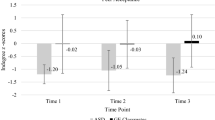Abstract
We examined social and behavioral characteristics of children selected by their teachers to serve as peer buddies for a child with autism. Thirty-one general education teachers and 576 children from five public elementary schools completed social status, behavioral, and peer buddy nomination measures. When compared to non-selected students, teacher selected buddies were: (a) more often boys, (b) popular, and (c) viewed as prosocial leaders by their peers. Agreement between teacher and peer nominations of social status and behavioral characteristics ranged from low to high; agreement between teacher and peer selected buddies was moderate.
Similar content being viewed by others
References
Bass, J. D., & Mulick, J. A. (2007). Social play skill enhancement of children with autism using peers and siblings as therapists. Psychology in the Schools, 44, 727–735. doi:10.1002/pits.20261.
Campbell, J. M., Ferguson, J. E., Herzinger, C. V., Jackson, J. N., & Marino, C. A. (2004). Combined descriptive and explanatory information improves peers’ perceptions of autism. Research in Developmental Disabilities, 25, 321–339. doi:10.1016/j.ridd.2004.01.005.
Carter, E. W., Hughes, C., Guth, C. B., & Copeland, S. R. (2005). Factors influencing social interaction among high school students with intellectual disabilities and their general education peers. American Journal of Mental Retardation, 110, 366–377. doi:10.1352/0895-8017(2005)110[366:FISIAH]2.0.CO;2.
Coie, J. D., & Dodge, K. A. (1983). Continuities and changes in children’s social status: A five-year longitudinal study. Merrill-Palmer Quarterly, 29, 261–282.
Coie, J. D., Dodge, K. A., & Coppotelli, H. (1982). Dimensions and types of social status: A cross-age perspective. Developmental Psychology, 18, 557–570. doi:10.1037/0012-1649.18.4.557.
DiSalvo, C. A., & Oswald, D. P. (2002). Peer-mediated interventions to increase the social interaction of children with autism: Consideration of peer expectancies. Focus on Autism and Other Developmental Disabilities, 17, 198–207. doi:10.1177/10883576020170040201.
Gifford-Smith, M. E., & Brownell, C. A. (2003). Childhood peer relationships: Social acceptance, friendships, and peer networks. Journal of School Psychology, 41, 235–284. doi:10.1016/S0022-4405(03)00048-7.
Hill, D. K., & Merrell, K. W. (2004). Characteristics of “controversial” children: An exploration of teacher and parents social behavior rating scale datasets. Psychology in the Schools, 41, 497–507. doi:10.1002/pits.10175.
Huesmann, L. R., Eron, L. D., Guerra, N. G., & Crawshaw, V. B. (1994). Measuring children’s aggression with teachers’ predictions of peer nominations. Psychological Assessment, 6, 329–336. doi:10.1037/1040-3590.6.4.329.
Ladd, G. W., & Profilet, S. M. (1996). The child behavior scale: A teacher-report measure of young children’s aggressive, withdrawn, and prosocial behaviors. Developmental Psychology, 32, 1008–1024. doi:10.1037/0012-1649.32.6.1008.
Laushey, K. M., & Heflin, J. (2000). Enhancing social skills of kindergarten children with autism through the training of multiple peers as tutors. Journal of Autism and Developmental Disorders, 30, 183–193. doi:10.1023/A:1005558101038.
Lease, A. M., Kennedy, C. A., & Axelrod, J. L. (2002). Children’s social constructions of popularity. Social Development, 11, 87–109. doi:10.1111/1467-9507.00188.
Masten, A. S., Morison, P., & Pellegrini, D. S. (1985). A revised class play method of peer assessment. Developmental Psychology, 21, 523–533. doi:10.1037/0012-1649.21.3.523.
Morgan, S. B., Walker, M., Bieberich, A., & Bell, S. (1996). The shared activities questionnaire. Unpublished manuscript, University of Memphis, Memphis, TN
Newman, R. S., & Murray, B. J. (2005). How students and teachers view the seriousness of peer harassment: When is it appropriate to seek help? Journal of Educational Psychology, 97, 347–365. doi:10.1037/0022-0663.97.3.347.
Parkhurst, J. T., & Hopmeyer, A. (1998). Sociometric popularity and peer-perceived popularity: Two distinct dimensions of peer status. The Journal of Early Adolescence, 18, 125–144. doi:10.1177/0272431698018002001.
Renk, K., & Phares, V. (2004). Cross-informant ratings of social competence in children and adolescents. Clinical Psychology Review, 24, 239–254. doi:10.1016/j.cpr.2004.01.004.
Roberts, C. M., & Lindsell, J. S. (1997). Children’s attitudes and behavioral intentions towards peers with disabilities. International Journal of Disability Development and Education, 44, 133–145. doi:10.1080/0156655970440205.
Rodkin, P. C., & Hodges, E. V. E. (2003). Bullies and victims in the peer ecology: Four questions for psychologists and school professionals. School Psychology Review, 32, 384–400.
Sasso, G. M., & Rude, H. A. (1987). Unprogrammed effects of training high-status peers to interact with severely handicapped children. Journal of Applied Behavior Analysis, 20, 35–44. doi:10.1901/jaba.1987.20-35.
Siperstein, G. N., & Bak, J. (1977). Instruments to measure children’s attitudes toward the handicapped: Adjective checklist and activity preference list. Unpublished manuscript, University of Massachusetts, Boston, MA
Swaim, K. F., & Morgan, S. B. (2001). Children’s attitudes and behavioral intentions toward a peer with autistic behaviors: Does a brief educational intervention have an effect? Journal of Autism and Developmental Disorders, 31, 195–205. doi:10.1023/A:1010703316365.
Vasa, S. F., Maag, J. W., Torrey, G. K., & Kramer, J. J. (1994). Teachers’ use and perceptions of sociometric techniques. Journal of Psychoeducational Assessment, 12, 135–141. doi:10.1177/073428299401200203.
Acknowledgments
The authors wish to acknowledge the assistance of Drs. Stephen Olejnik and Michele Lease who helped with creating measures and analyzing data. The paper is based upon the first author’s doctoral dissertation.
Author information
Authors and Affiliations
Corresponding author
Rights and permissions
About this article
Cite this article
Jackson, J.N., Campbell, J.M. Teachers’ Peer Buddy Selections for Children with Autism: Social Characteristics and Relationship with Peer Nominations. J Autism Dev Disord 39, 269–277 (2009). https://doi.org/10.1007/s10803-008-0623-1
Received:
Accepted:
Published:
Issue Date:
DOI: https://doi.org/10.1007/s10803-008-0623-1




